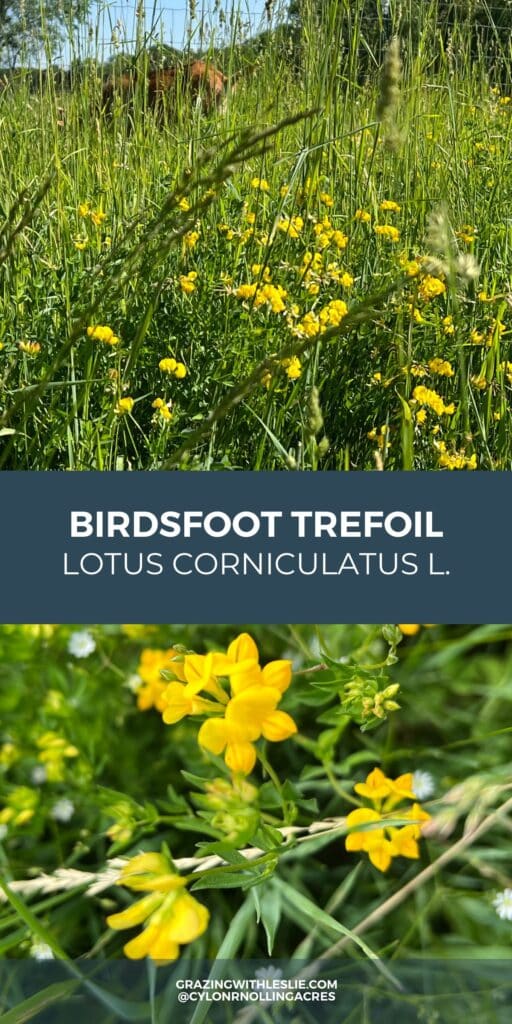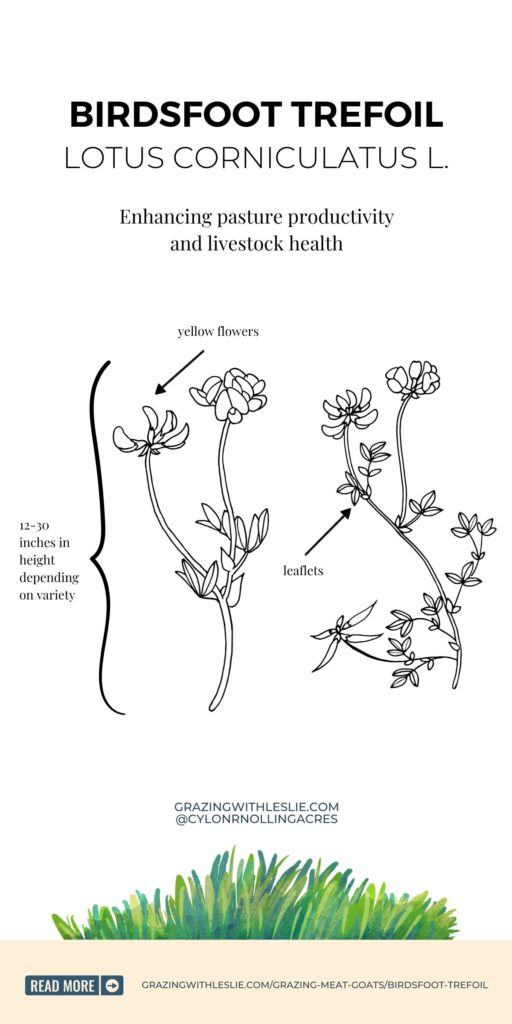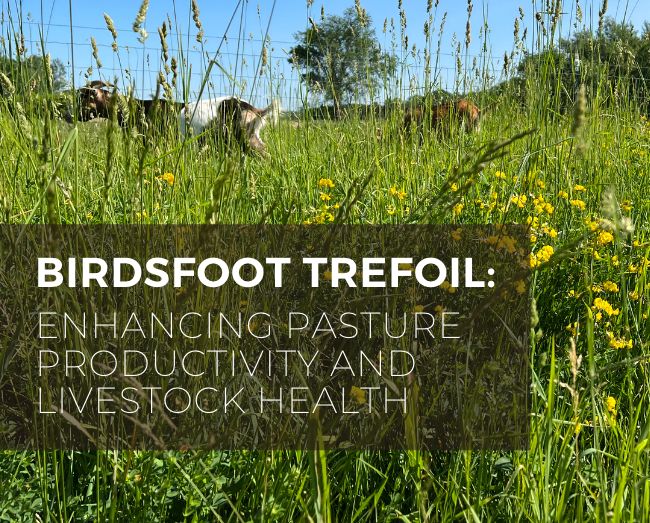While often overlooked as a pasture legume, Birdsfoot Trefoil is an excellent option to consider given it’s forage quality, long lifespan as a plant, and antiparasitic traits.
I’m a big fan of diversity in our pastures where we graze our goats and sheep. Diversity gives us more stability over the entire grazing season since plant species will vary in their growth stages, root depth, climate tolerance and so on.
From a livestock perspective, we want to have high quality pasture as much as possible throughout the growing season so we can support our sheep and goats no matter their production purposes – lactating and feeding kids or lambs, or in growth mode building muscle for meat. How we mange and graze our pastures matters, but diversity in our plant species will also help support the growth and health of our livestock.
This is where Birdsfoot Trefoil comes in. It can be a great component to consider adding into your pasture species mix, if you have access to seed varieties that are well suited for your climate or soil type.
Understanding Birdsfoot Trefoil
Birdsfoot Trefoil, also known by its scientific name as Lotus corniculatus L., is a legume typically used in pastures. However, it can be used in hayfields as well. It’s a perennial, giving it more longevity for your planting.
Birdsfoot Trefoil does well in poorly drained and acidic soils. It’s shallow rooted and doesn’t do well in sandy soils.

Types of Birdsfoot Trefoil
There are several types of the plant species:
- Prostrate – low growing, more winter hearty, slower recovery, more adapted for grazing, slower getting established
- Erecting types – better for haying
- Semi-erected – dual purpose and most common, all can be grazed
Birdsfoot Trefoil Identification
Birdsfoot Trefoil physical characteristics include a smooth leaf with five leaflets, where each leaf has five “leaf like” stipules. Three of these are attached at the end of the petiole and two are at the base of the plant.
Its stems are fine with branches. At maturity, Birdsfoot Trefoil is 12-30 inches in height depending on the variety.
Birdsfoot Trefoil has yellow flowers, which bloom over 3-8 weeks throughout the growing season until fall.

Varieties of Birdsfoot Trefoil
There are many different varieties of Birdsfoot Trefoil, some doing better in more northern climates, while others do better in more southern states of the U.S. The chart below highlights some of the characteristics of the different varieties of Birdsfoot Trefoil.
Characteristics of different varieties of Birdsfoot Trefoil
| Variety | Type | Winter Hardiness* | Traits |
|---|---|---|---|
| AU-Dewey | semi-erect | low to moderate | adapted to southeastern states; developed for persistence in humid pastures |
| Bruce | semi-erect | high | rapid grazing regrowth, one of the highest condensed tannin levels commercially available |
| Carroll | semi-erect to erect | high | good seedling vigor, yields are as good as or better than Empire |
| Dawn | semi-erected | moderate to high | good yields, excellent fall growth good grazing tolerance, adapted to southern corn belt |
| Empire | prostrate | high | good tolerance to grazing, adapted to wetter soils, harder to establish |
| Fergus | semi-erect | moderate | adapted to southeastern states, good grazing tolerance, developed for persistence in humid pastures |
| Georgia-1 | semi-erect | moderate | adapted to southeastern states, more tolerance of acidic soils |
| Leo | semi-erect to erect | moderate to high | very good seedling vigor |
| Mackinaw | semi-erect | high | similar to Norcen and Viking |
| Maitland | erect | moderate to high | above-average seedling vigor, suited for hay |
| Norcen | semi-erect to erect | high | good yields, best winter hardiness |
| Pardee | semi-erect to erect | moderate to high | rapid growth, higher condensed tannin levels commercially available, lower than Bruce |
| Viking | erect | moderate | excellent seedling vigor, good yields, good regrowth, suited for hay |
*Moderate to high is recommended for northern states
References: Undersander, et al., (1993), and Forage-Based Parasite Control in Sheep and Goats in the Northeast U.S (2014).
Advantages for Grazing Livestock
Birdsfoot Trefoil has a number of advantages for livestock when it’s incorporated into a pasture mix, including being a high quality feed forage, having antiparasitic properties, and no bloating side effects.
Quality feed source
The first benefit is its ability to enhance forage productivity and quality with a higher protein content. In fact, Birdsfoot Trefoil has a very similar nutritional profile to alfalfa throughout the growing season. The only difference is when Birdsfoot Trefoil reaches the flowering stage, it does not lose nutritional quality like alfalfa does.
Antiparasitic properties
Birdsfoot Trefoil has antiparasitic properties due to its condensed tannins, which is very beneficial for farmers and ranchers raising sheep and goats. It can lead to improved animal health and performance.
Condensed tannins have been demonstrated to suppress intestinal parasites, in particular the deadly barber pole worm, also known as Haemonchus contortus. While feeding forages with more tannins it’s possible to decrease the need for using dewormers.
Several research projects (University of Rhode Island) have shown promising results:
- On pastures with Birdsfoot Trefoil of 25% dry matter or greater, weaned lambs and kids could grow faster than a control pasture without Birdsfoot Trefoil, and young stock showed increased resilience to barber pole worm.
- In a three year trial, 60%+ lambs on Birdsfoot Trefoil didn’t need dewormer, compared to only 33% on the control pasture without Birdsfoot Trefoil.
Reduces bloat risk
Birdsfoot trefoil, unlike other legumes such as alfalfa and clover, doesn’t cause bloat in ruminants, due to the presence of condensed tannins (USDA OREI Project, 2014).
Birdsfoot Trefoil Planting Guide
While Birdsfoot Trefoil has numerous benefits, it can be a more challenging legume to establish in pastures. Sometimes it won’t show up until several years after being planted.
Site prep for planting
Since it can take longer to establish, Birdsfoot Trefoil can be easier to get started in bare, tilled soil. It is more challenging to plant with frost seeding or interseeding, but it can be done.
Birdsfoot Trefoil seed is a small, round brown seed about 1.2-1.7 mm in diameter.
Seeding rate
The seeding rate for Birdsfoot Trefoil is:
- 8-12 lb/acre as single stand, however planting as a single stand is less common
- 6 lb/acre as a seed mix
Planting a new stand
When planting Birdsfoot Trefoil as a new stand in a field, pasture or food plot, a forage seed drill works best for planting. If the drill doesn’t have a press wheel, follow up with a cultipacker, roller or even a light drag to help make sure there’s seed to soil contact for germination.
Due to the hardness of the seed, Birdsfoot trefoil seed germination can sometimes be delayed.
For pure stands, a nurse crop such as oats or barley could be added to help suppress other plant growth until the Birdsfoot Trefoil germinates and establishes the first growing season.
Planting timing: It’s best to establish it in the spring. Birdsfoot Trefoil seed requires about the same temperature, if not slightly warmer, than alfalfa for germination. Planting can also be done in the late summer for northern climates as well.
Planting for pasture improvement
There are two primary ways to plant Birdsfoot Trefoil into an existing pasture: no-till planting or frost seeding.
No-till planting
Over-graze the pasture low in late summer or fall before seeding with a no-till drill to set back the existing pasture species so the Birdsfoot Trefoil can get established. Mowing can also be done in place of grazing.
Frost seeding
Before fall mow or closely graze the planting site. Then frost seed in early spring when the ground is still frozen, broadcasting the seed mix by hand or with a seed broadcaster.
Birdsfoot Trefoil Seed Mixes
Birdsfoot Trefoil does well in seed mixes with companion grasses, such as perennial Kentucky bluegrass or Timothy since they’re slower growing and won’t choke out the Birdsfoot Trefoil. White clover is another option to add into a mix with grasses since it has a lower canopy.
On our farm, we have used Orchard Grass in our pasture mix, along with other plant species and it hasn’t been an issue with our Birdsfoot Trefoil. However, this is likely due to the fact that it’s a very diverse pasture mix instead of just an Orchard Grass-Birdsfoot Trefoil mix.
Managing new stands of Birdsfoot Trefoil
A common approach with new pasture plantings is to graze it less the first year to allow for the new plants to get established. However, with Birdsfoot Trefoil this can be more harmful. It is actually better to graze it as usual to make sure the companion grasses and plants in the field do not overtake the stand, impacting or slowing down the establishment of Birdsfoot Trefoil (Understander, etc).
Stand life
Birdsfoot Trefoil lifespan is about 2-3 years. However, if it’s left to reseed it will continue to reestablish itself, making it a long term legume option. Each flower produces a seed pod that when dropped tends to reseed fairly easily.
Grazing Strategies with Birdsfoot Trefoil
During the first season of grazing a pasture with Birdsfoot Trefoil it is actually acceptable to graze it as you’d usually graze a paddock instead of grazing lighter. This allows for it to be able to get established with taller-growing grasses and legumes.
In general, recommendations for grazing heights the first season of grazing are 8-12 inches high and subsequent seasons, no lower than 4 inches (Cosgrove & Undersander, 2003).
Grazing Birdsfoot Trefoil while it is flowering is not an issue either. In fact, when grazed at the flowering stage, it still provides good forage quality to your livestock, as compared to alfalfa where the quality starts to decrease (Cosgrove & Undersander, 2003).
Birdsfoot Trefoil with Goats and Sheep
On our farm Cylon Rolling Acres, we’ve incorporated Birdsfoot Trefoil into our existing pastures for many of the reasons listed above. However, the most appealing aspects of this plant species for our sheep and goat grazing operation has been its high quality forage value, low bloat risks, and anti parasitic characteristics.
We established the Birdsfoot Trefoil into our pastures after a low graze and no tilled it into the existing sod. It took a few grazing seasons to see it start to get established, but now we have a nice mix of it in our pastures.
Birdsfoot Trefoil for Deer and other Wildlife
Birdsfoot Trefoil is also an option for a perennial deer food plot mix due to its annual growth, reseeding, and extended forage quality throughout the growing season.
Planted along with perennial grasses, such as Timothy and Kentucky Bluegrass for nitrogen fixation, it could also could be mixed with white and other types of clover. This combination includes lower canopy plant species to allow the Birdsfoot Trefoil to get established and keep growing.
On our farm, I’m often looking to deer food plot mixes for inspiration for our goat pastures since goats and deer are both ruminants and have similar dietary preferences. In reverse, my husband, who’s an avid deer hunter, is always willing to try my seed mixes in the areas of our farm where he also hunts white tail deer in the fall.
References:
- Birdsfoot trefoil for grazing and harvested forage. (1993). North Central Regional Extension Publication.
- Cosgrove, D., and Undersander, D. (2003). Identifying pasture legumes. University of Wisconsin-Extension.
- Effects of feeding birdsfoot trefoil on parasite control, nutritional status and profitability. University of Rhode Island.
- Forage-Based Parasite Control in Sheep and Goats in the Northeast U.S. (2014). USDA Organic Agriculture Research and Extension Initiative (OAREI) Project.
- MacAdam J., Griggs, T., Beuselinck, P., and Grabber, J. (2006). Birdsfoot Trefoil, a Valuable Tannin-Containing Legume for Mixed Pastures.

I have excellent Birdsfoot trefoil on very sandy, very acidic, wet cool summer, cold dry winter Highveld South African pastures
That’s great to hear!